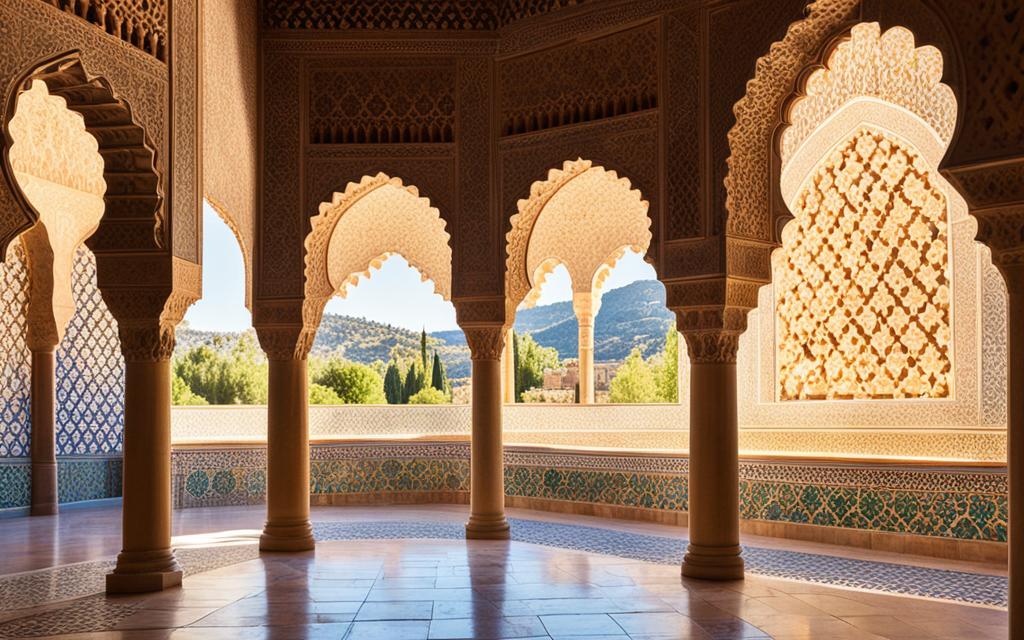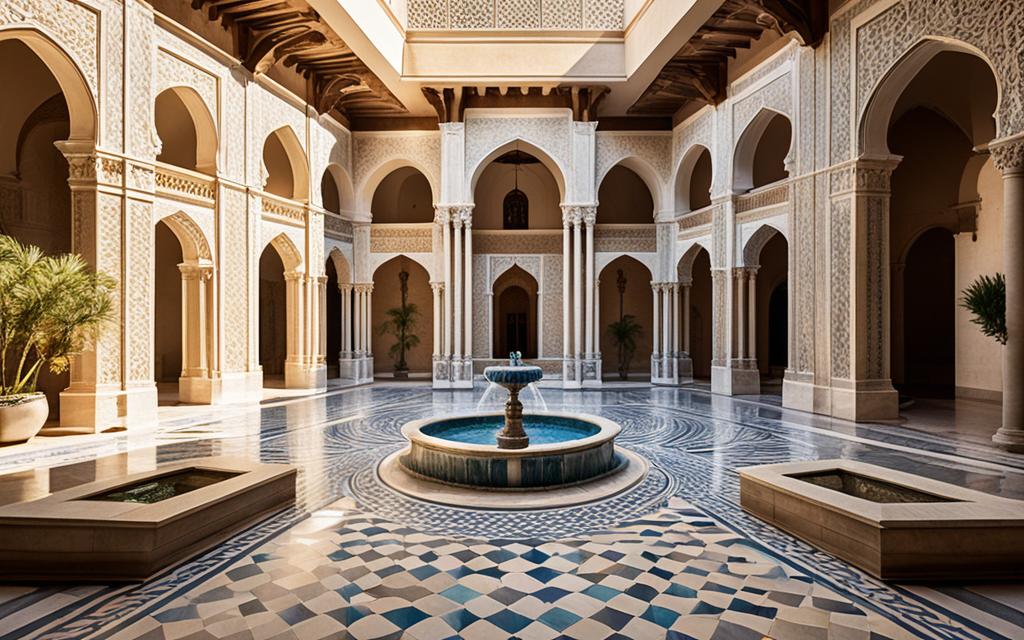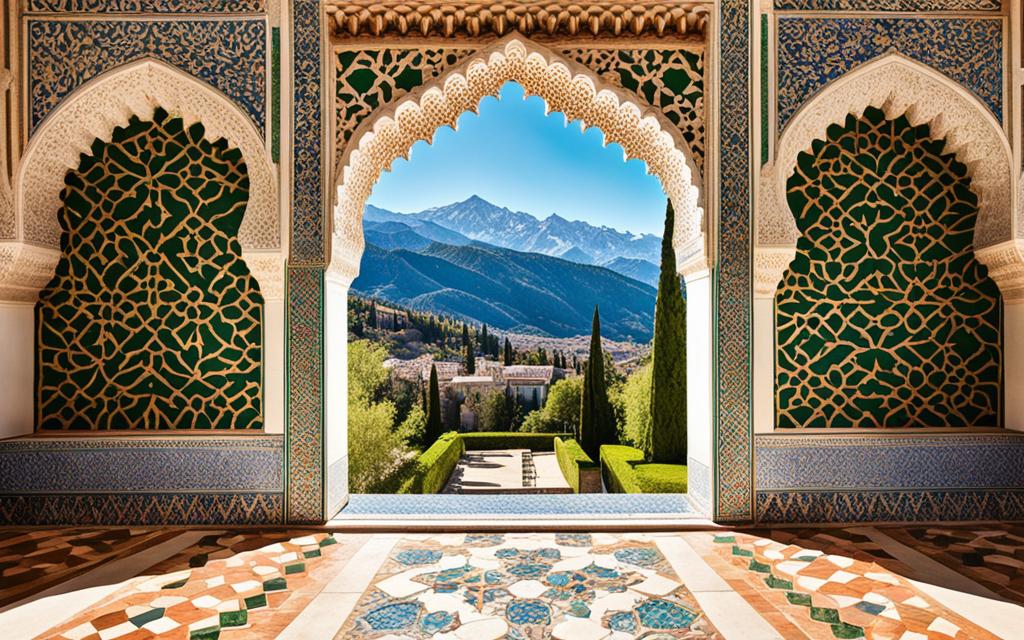Stepping into the Alhambra is like entering another world. The busy Granada streets quickly disappear. You find yourself in a place filled with Islamic art and Moorish architecture. The Alhambra is both a palace and a fortress. It’s a key symbol of Spain’s Nasrid dynasty’s cultural legacy.
From the 13th to the 14th centuries, the Alhambra was a royal home and an important administrative site for Granada’s Moorish kingdom. Its significance is so strong that today it’s a UNESCO World Heritage Site. Visitors are greeted by stunning tile designs and panoramic views. It truly is a sight to behold.
Key Takeaways
- The Alhambra is a stunning Moorish palace and fortress complex located in Granada, Spain.
- It is renowned for its exquisite Islamic architecture, intricate decorative elements, and breathtaking views.
- The Alhambra was constructed during the Nasrid dynasty in the 13th and 14th centuries and has been a UNESCO World Heritage Site since 1984.
- The palace complex features the Generalife gardens, a separate oasis of tranquility, and the awe-inspiring Court of the Lions.
- Ongoing conservation efforts ensure the preservation of the Alhambra’s unique legacy and the architectural achievements of the Nasrid dynasty.
The Alhambra: A Moorish Architectural Marvel
The Alhambra traces its roots back to the Nasrid dynasty, which governed the Moorish Emirate of Granada from the 13th to the 15th century. It started construction in the 11th century, but most of its famous features came about in the Nasrid era. During that time, the complex served as the royal home and center of governance for the Moorish kingdom.
Tracing the Origins of the Alhambra
In the 11th century, the Alhambra began. But, it was during the Nasrid dynasty that it turned into the Moorish architectural marvel we know now. The Nasrid rulers loved Islamic art and design, and under their command, many of the Alhambra’s iconic parts were built.
The Influence of Islamic Art and Architecture
The Moorish palaces and historic monuments at the Alhambra are full of detailed artwork. They’re a great example of Islamic art and design. The Nasrid architects and creators made the Alhambra stunning. They combined designs, tiles, and delicate plaster to make a beautiful place in Granada, Spain.

Exploring the Architectural Wonders of the Alhambra
Visitors to the Alhambra find themselves surrounded by beautiful Moorish architecture and Islamic art and design. The walls, ceilings, and courtyards are filled with stunning details. Moorish craftsmen used techniques such as carved stucco and intricate tile work to wow everyone.
The Intricate Decorative Elements
The Alhambra’s beauty shows off the Nasrid dynasty’s craftsmanship. Everywhere you look, from walls to fountains, there’s something to marvel at. This careful work and the big amount of detail used truly make the Alhambra a standout. It shows off what Moorish architecture and Islamic art and design are all about.

The Awe-Inspiring Court of the Lions
The Court of the Lions is truly a sight to see, with its delicate arcade and marble columns. Its centerpiece, the Fountain of the Lions, is a masterpiece. The artistry and proportions of this Granada, Spain landmark have impressed people for ages. It’s a key highlight for those who want to experience the Alhambra’s beauty.
The Generalife Gardens: An Oasis of Tranquility
The Generalife complements the Alhambra, offering lush Moorish gardens. These gardens are a peaceful escape in Granada, Spain. They allow visitors to enjoy beautiful Moorish design away from the city’s hustle.
The Generalife Gardens are carefully laid out. They have cool walkways, glistening fountains, and colorful flower beds. These features highlight how well the Alhambra blends nature and building design.
As visitors explore, they smell the fresh roses and hear water flowing. They also see stunning views of Granada’s historic monuments. This journey combines beautiful sights and tranquility.
The gardens are a peaceful spot next to the impressive Alhambra. Here, visitors can relax and enjoy the beautiful Moorish gardens. It’s a living example of the Nasrid dynasty’s love for nature and architecture’s harmony with the natural world.
The Alhambra as a UNESCO World Heritage Site
In 1984, the Alhambra became a UNESCO World Heritage Site. This title acknowledges its vast historical, cultural, and architectural importance. The Alhambra enjoys ongoing efforts to conserve and protect it. This ensures its role as a prime example of the Nasrid dynasty’s achievements.
Preserving the Legacy of the Nasrid Dynasty
The Alhambra’s UNESCO status plays a key role in preserving the Nasrid dynasty’s legacy. The dynasty was behind the building and growth of this stunning palace. Through detailed conservation work and planning, the Alhambra’s beauty and historical value are kept intact. This is so the future can continue to find wonder and insight here.
Ongoing Conservation Efforts
Keeping the Alhambra as a World Heritage Site involves a lot of dedication. Expert teams of conservators, archaeologists, and historians do vital work here. They repair harm, protect the site from damage, and promote sustainable tourism. So, the Alhambra in Granada, Spain, remains a must-see place for visitors. It’s a true gem showcasing the Nasrid dynasty’s rich architectural and cultural heritage.




